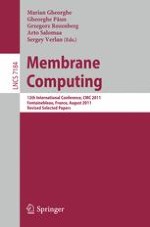2012 | Buch
Membrane Computing
12th International Conference, CMC 2011, Fontainebleau, France, August 23-26, 2011, Revised Selected Papers
herausgegeben von: Marian Gheorghe, Gheorghe Păun, Grzegorz Rozenberg, Arto Salomaa, Sergey Verlan
Verlag: Springer Berlin Heidelberg
Buchreihe : Lecture Notes in Computer Science
